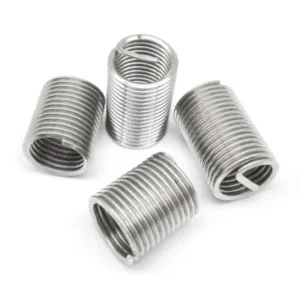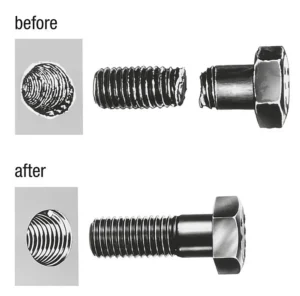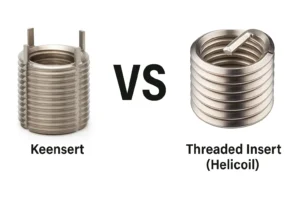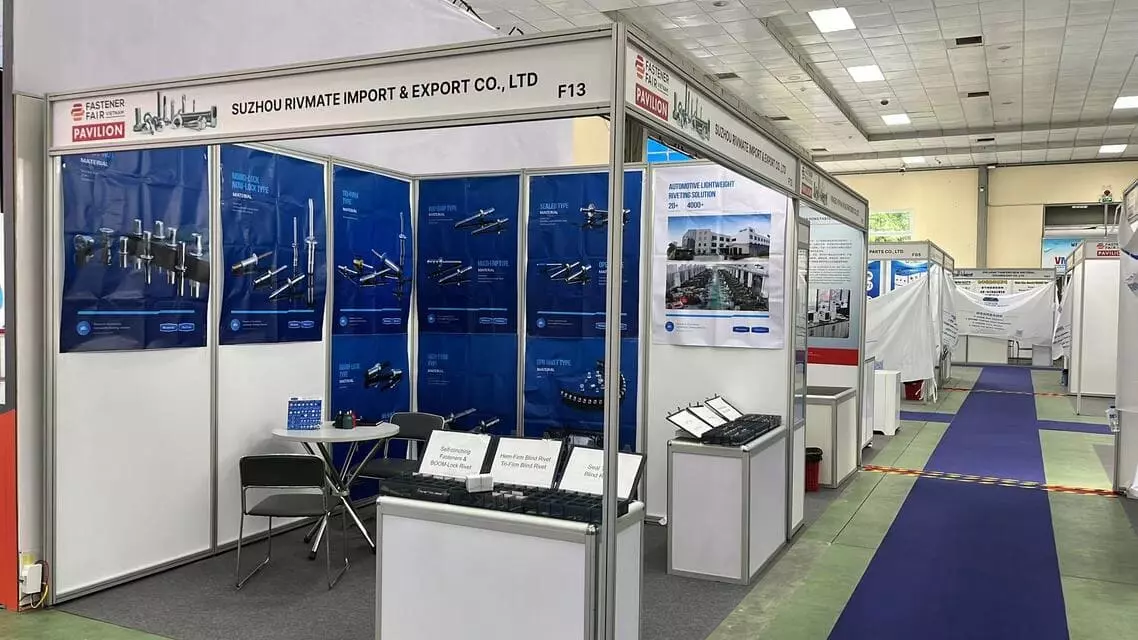What Is A Helicoil Insert Used For?
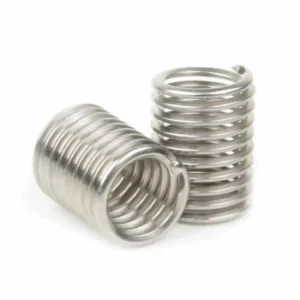
Leading Thread Insert Manufacturer and Supplier in China
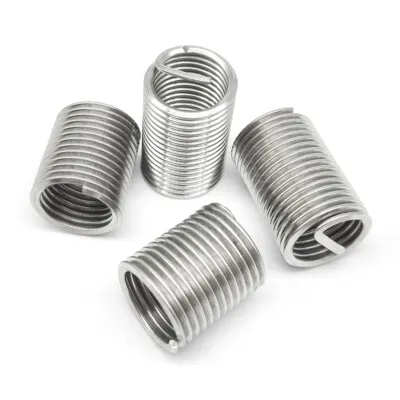
What Is A Helicoil Insert Used For? In the field of mechanical manufacturing and maintenance, a “helicoil insert” typically refers to a precision metal thread insert (also known as a thread repair sleeve) used for repairing or reinforcing internal threads. It has a helical spring-like structure and forms a high-strength, wear-resistant new thread surface when installed in a threaded hole. This extends the lifespan of parts and enhances the reliability of connections. This design can restore threads that have failed due to cross-threading, corrosion, or excessive wear. It can also significantly increase the load-bearing capacity of threads in soft materials such as aluminum and magnesium alloys.
Helicoil inserts are often made of high-performance metals such as stainless steel, titanium alloy, and nickel-based alloys. These materials possess excellent corrosion resistance, high-temperature resistance, and mechanical strength. During the manufacturing process, the helical coils are precisely formed and surface treated to ensure that they can evenly distribute the axial load of the bolt after installation. This reduces stress concentration in the threads and thereby lowers the risk of fatigue failure.
Table of Contents
Why Helicoil Inserts Are Needed?
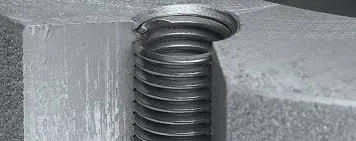
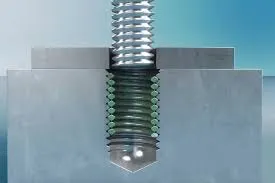
In the process of mechanical assembly and maintenance, thread stripping, wear and corrosion are common fault problems. In severe cases, they can cause connecting parts to loosen or even fall off, affecting equipment safety and normal operation. Helicoil Insert, as an efficient solution for thread repair and reinforcement, has the following key functions:
Prevent thread slippage, wear and corrosion
Threaded holes are prone to damage due to friction, vibration or corrosion during long-term use or frequent disassembly and assembly. Helicoil Insert is made of highly corrosion-resistant stainless steel and its spring-like structure disperses the load, reduces local stress concentration, effectively prevents thread stripping and excessive wear, thereby maintaining the stability and reliability of fasteners.
Enhancing the Thread Strength of Soft Materials
Lightweight alloy materials such as aluminum and magnesium are soft and have low strength, making the internal threads prone to being pulled out or stripped. After installing Helicoil Insert, a high-strength stainless steel thread layer is actually formed within the soft material, significantly enhancing the thread’s tensile strength and wear resistance. According to multiple test data, the tensile strength of the thread can be increased by more than 30% to 50% after using Helicoil, significantly improving the connection safety.
Extending the service life of parts and reducing maintenance costs
By repairing damaged threads and enhancing thread strength, Helicoil Insert not only extends the service life of components but also reduces the frequent maintenance and replacement costs caused by thread damage. In the aerospace and automotive industries, reliable thread connections are directly related to the safety performance and operational efficiency of equipment. Therefore, the adoption of Helicoil technology has become an industry standard.
Core Uses – What Is A Helicoil Insert Used For?
The Helicoil Insert, with its unique structural design and high-performance materials, has become an ideal solution for various screw-related problems. Its main applications include:
a. Thread Repair
When the threaded holes of mechanical parts are damaged due to excessive use, corrosion or improper installation, the traditional method of replacing the parts is costly and time-consuming. The Helicoil Insert can quickly restore the damaged threads, reconstruct the standard thread size and shape, and ensure the assembly accuracy and reliability of fasteners. The strength of the repaired threads can even approach or exceed the original state, significantly reducing maintenance costs and downtime.

b. Thread reinforcement
In soft materials such as aluminum alloys, magnesium alloys or engineering plastics, the threaded sections obtained through direct cutting have limited load-bearing capacity and are prone to failure due to stress concentration. After installing Helicoil Insert, a robust stainless steel threaded sleeve can be formed within the soft material, effectively distributing the load and enhancing the load-bearing capacity and durability of the threads. This feature is widely applied in high-strength connection scenarios such as aerospace and automotive engines.
c. Anti-loosening
The spring structure of the Helicoil Insert can provide continuous elasticity and friction force when the fastener is subjected to vibration or periodic loads, significantly reducing the risk of thread loosening. It is particularly suitable for scenarios with extremely complex vibration environments such as aircraft, racing cars, and heavy machinery, ensuring that the connection components remain stable under long-term and high-frequency vibration conditions.
d. Resistance to Corrosion and High Temperature Resistance
Helicoil Insert is mostly made of corrosion-resistant stainless steel. Some high-end models even use titanium alloy or nickel-based alloy, which can adapt to environments with strong corrosivity and drastic temperature changes. Typical applications include turbine shells of aircraft engines, high-temperature chemical equipment, and military equipment, ensuring that the threaded connections can operate reliably for a long time in extreme conditions.
Industries & Scenarios of Helicoil Insert
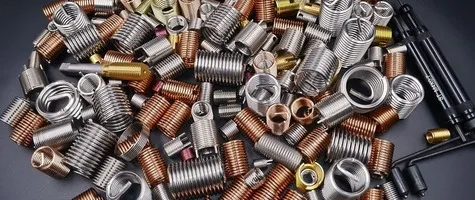
Helicoil Insert is widely used in various high-strength and high-precision connection scenarios. The aerospace field is one of its most important application areas. Aircraft engines and fuselage structures need to maintain the stability and safety of the connection under extreme high temperatures, high pressures, and vibrations. Helicoil Insert enhances the wear resistance and corrosion resistance of the threads, ensuring the long-term reliable operation of these critical components.
In the automotive industry, parts such as engine blocks and transmission housings often use aluminum alloy materials. These materials inherently have relatively low thread strength. After installing Helicoil Inserts, not only can damaged threads be effectively repaired, but the bearing capacity of the threads is significantly enhanced, thereby improving the overall durability and performance stability of the engine and transmission system. This is of vital importance for ensuring the safety and performance of the vehicle under various driving conditions.
The electronic equipment manufacturing industry also extensively uses Helicoil Inserts, especially in the threaded parts of the equipment shells and the internal connection interfaces. Its high precision and wear resistance ensure the integrity of the threads after repeated disassembly, enhancing the maintenance convenience and service life of the products. It meets the increasingly stringent quality requirements of consumer and industrial electronic equipment.
In the field of industrial machinery, equipment such as molds and machine tools have extremely high requirements for the strength and stability of threaded connections. Helicoil Insert enhances the bearing capacity of the threads, effectively prolonging the service life of the equipment and reducing the frequency of maintenance.
How Helicoil Inserts Work?
①. The spring structure of the threaded sheath and its mechanism of action
The Helicoil Insert is a spiral-shaped threaded sleeve made of high-strength stainless steel wire. Its unique spring structure enables the sleeve to slightly deform during installation, allowing it to closely adhere to the inner wall of the mating threaded hole. After installation, the Helicoil threaded sleeve returns to its elastic tension and securely locks in the threaded hole, forming a sturdy and durable internal threaded surface.
This design effectively distributes the force on the bolts, reduces the phenomenon of stress concentration, and minimizes the risks of thread fatigue and thread slippage. At the same time, the spring structure endows the sheath with a certain buffering capacity, enabling the connection to maintain a tight state even when subjected to vibration or thermal expansion and contraction, thereby enhancing the stability and reliability of the overall connection.
②. Required Tools for Installation
Installing the Helicoil Insert requires a set of professional tools, including:
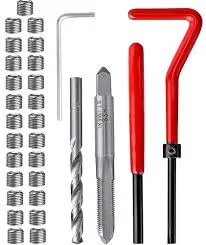
- Tap: This is used to machine the appropriate thread size within the hole to ensure that the protective sleeve can be smoothly inserted and tightened.
- Installation Tool: This is used to accurately insert the threaded sleeve into the pre-processed threaded hole.
- Tang Break-off Tool: After installation, this is used to break off the positioning rod at the inner end of the sleeve to ensure that it does not affect the threaded connection.
Furthermore, to ensure the installation quality, it is recommended to use a torque wrench to pre-tighten the threaded holes and fasteners to prevent secondary damage caused by insufficient or excessive torque.
③. Installation Steps and Precautions
- Clean the holes: Ensure that there is no oil, iron filings or other impurities inside the holes to be installed.
- Thread processing: According to the model of the Helicoil, use the corresponding tap to process the internal threads in the holes. The cutting depth and thread angle must comply with the product specifications.
- Install the sleeve: Insert the Helicoil threaded sleeve into the installation rod and slowly screw it into the machined threaded hole until the bottom of the sleeve is level with the hole opening.
- Break the positioning rod: Use a breaking rod to break the positioning rod inside the sleeve to avoid affecting the insertion of the fastener.
- Check the quality: Confirm that the sleeve is installed firmly, the threads are unobstructed, and it is recommended to conduct a trial installation using a bolt of the corresponding specification.
Note: During the installation process, avoid excessive deformation or distortion of the protective cover to prevent any impact on the subsequent thread strength and connection stability. For critical equipment, it is recommended to have it installed by professional technicians or operators who have received training.
Advantages & Limitations of Helicoil Inserts
Advantages
High Strength and Durability
The Helicoil Insert is made of high-strength stainless steel or titanium alloy, featuring excellent mechanical strength and corrosion resistance. After installation, it significantly enhances the overall strength of the threaded connection, especially in soft materials such as aluminum alloys. Multiple experiments have shown that the tensile strength of the threads can be increased by 30% to 50% after using Helicoil, thereby extending the service life of the components.
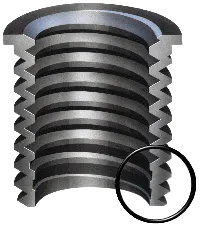
Reduce thread wear
The spring structure of Helicoil effectively distributes the load and friction, preventing local excessive wear of the threads and reducing the risk of thread slippage during disassembly and assembly. It is particularly suitable for equipment connections that require frequent disassembly and maintenance, thereby improving maintenance efficiency and safety.
Excellent performance in repeated disassembly and reassembly
Due to the elasticity and high hardness of the sheath material, the Helicoil Insert enables multiple bolt disassembly and assembly without causing the failure of the threaded holes, making it suitable for mechanical equipment that requires long-term use and periodic maintenance.
Limitations
Requires special tools
Installing Helicoils requires the use of specialized tools such as taps, installation rods, and break-off rods. It also demands certain technical skills from the operators, thereby increasing the maintenance threshold and training costs.
The installation process is relatively complex
Compared with traditional thread repair methods, the Helicoil installation process is more complicated. It requires strict adherence to standard procedures; otherwise, it may affect the installation quality and thread performance.
In high-cost manufacturing, one must consider the economic aspects
Although Helicoil can extend the lifespan of components, its material cost and installation labor cost are relatively high. In some low-cost or mass production environments, it is necessary to weigh the actual needs and economic benefits before deciding whether to adopt this solution.
Helicoil vs Other Thread Repair Solutions
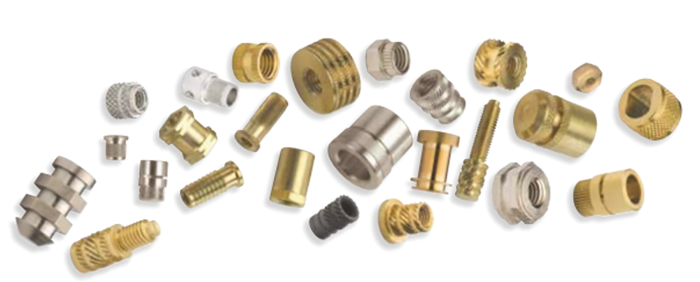
In the field of thread repair, apart from Helicoil Insert, the common solutions include Threaded Rivet Inserts, Solid Thread Inserts, and Adhesive Thread Repair Compounds. Each solution has its own advantages and disadvantages, and is suitable for different application scenarios. The following provides a comparative analysis from the aspects of performance, cost, installation time, lifespan and load-bearing capacity:
| Repair Solution | Material Type | Installation Difficulty | Service Life | Load Capacity | Typical Application Scenarios |
|---|---|---|---|---|---|
| Helicoil Insert | Spring steel, stainless steel, titanium alloy | Medium (requires special tools) | Long-lasting (high wear resistance) | High (improves by 30%-50%) | Aerospace, automotive engines, machinery repair |
| Threaded Rivet Nut | Solid metal rivet nut | High (requires riveting tools) | Long-lasting | Relatively high | Heavy-load mechanical structures, heavy industry |
| Solid Threaded Insert | Stainless steel, copper, other solid materials | Low (mechanical press-in or threaded insertion) | Long-lasting | Very high | High-strength connections, mold manufacturing |
| Adhesive Repair Compound | Chemical adhesives | Low (easy to operate) | Short- to medium-term | Low to medium | Light-load or temporary repairs |
Performance Comparison
- The spring structure of the Helicoil Insert offers excellent elasticity and load-bearing capacity, especially suitable for frequent disassembly and vibration conditions, with outstanding fatigue resistance.
- The threaded rivet sleeve and solid rivet sleeve have a sturdy structure and extremely high load-bearing capacity, making them suitable for heavy-duty and high-strength mechanical connections. However, their installation is complex and the cost is high.
- The adhesive repair agent is suitable for light-load environments or temporary repairs, but is not suitable for high-strength or high-frequency disassembly scenarios.
Cost and Installation Time
- The installation of Helicoil requires specialized tools and certain technical skills, but the overall working time is relatively short and the cost performance is quite good.
- The installation process of threaded rivets and solid rivets is cumbersome, the required equipment is expensive, and the working time is long with high maintenance costs.
- The adhesive repair agent is simple and quick to operate, but its lifespan is limited and the long-term maintenance cost may be higher.
Service Life
- Helicoil and metal sleeves have a long service life and are suitable for long-term high-intensity use.
- Adhesive repair agents have a shorter lifespan and are mostly used for emergency or light-load applications.
Conclusion
Helicoil Insert, as an efficient and reliable solution for thread repair and reinforcement, demonstrates outstanding mechanical strength, wear resistance, and corrosion resistance. It plays a crucial role in various key fields such as mechanical manufacturing, aerospace, and automotive industry. It not only enables rapid restoration of damaged threads, enhances the load-bearing capacity of soft materials, but also effectively prevents thread failure caused by vibration and corrosion. It significantly extends the service life of equipment and substantially reduces maintenance and replacement costs.
Selecting and correctly installing the Helicoil Insert is of vital importance for ensuring the safety and stability of the equipment. For different application environments and thread specifications, it is recommended that users consult professional suppliers or technical service teams. Choose the product model and installation solution that best suits your needs.
If you are encountering issues such as damaged threads or insufficient connection strength, please contact a professional Helicoil supplier. Obtain customized solutions and technical support immediately to help your equipment achieve long-term and efficient operation.
Do You Have Any Questions?
Let Us Solve Your Problem
Stronger Threads, Longer Life
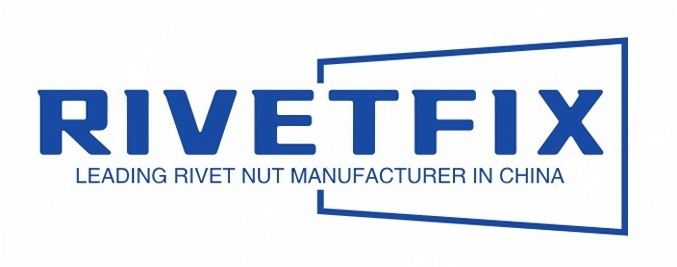
Rivetfix’s Helicoil Insert offers you outstanding strength enhancement and durability guarantee. Our products are manufactured from high-quality stainless steel and titanium alloy, and undergo strict process control. This ensures they remain stable even under high tension, frequent disassembly and assembly, and strong vibrations, among other demanding conditions.
Choose Rivetfix, and you are choosing to make your equipment connections stronger, more durable and more secure – Order now and inject professional-grade thread repair and reinforcement solutions into your project!
Get High Quality Rivet Nuts Quote!
Send Your Rivet Nut Request
For more than 20 years, Rivetfix has helped customers solve many rivet nuts sourcing needs and technical challenges.
Have a question? Contact us and we’ll provide you with the perfect solution.

